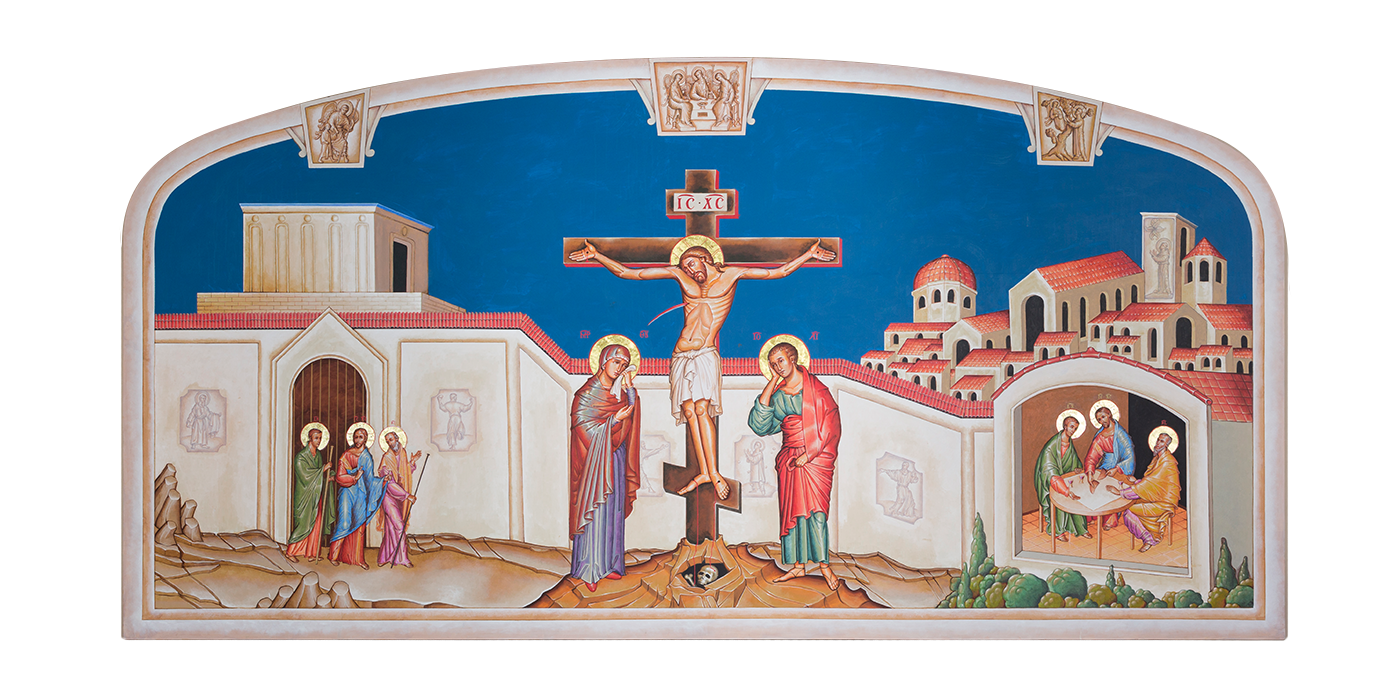
Crucifixion of Christ
Monastery Refectory | 75″ x 150.5″
This piece is the center of the mural and the entire Salve Suite as it is the core mystery of our redemption. It depicts the crucified Jesus, blood and water flowing from his side, and blood at his feet dripping on the bones of Adam. The Virgin Mary and St. John are at the foot of the cross. To the left of the scene, the resurrected Jesus walks the road to Emmaus with the two disciples. At the right of the scene Christ breaks the bread with them, where they realized his identity. Small scenes from the stoning of St. Stephen are shown in the walls of Jerusalem in the background.
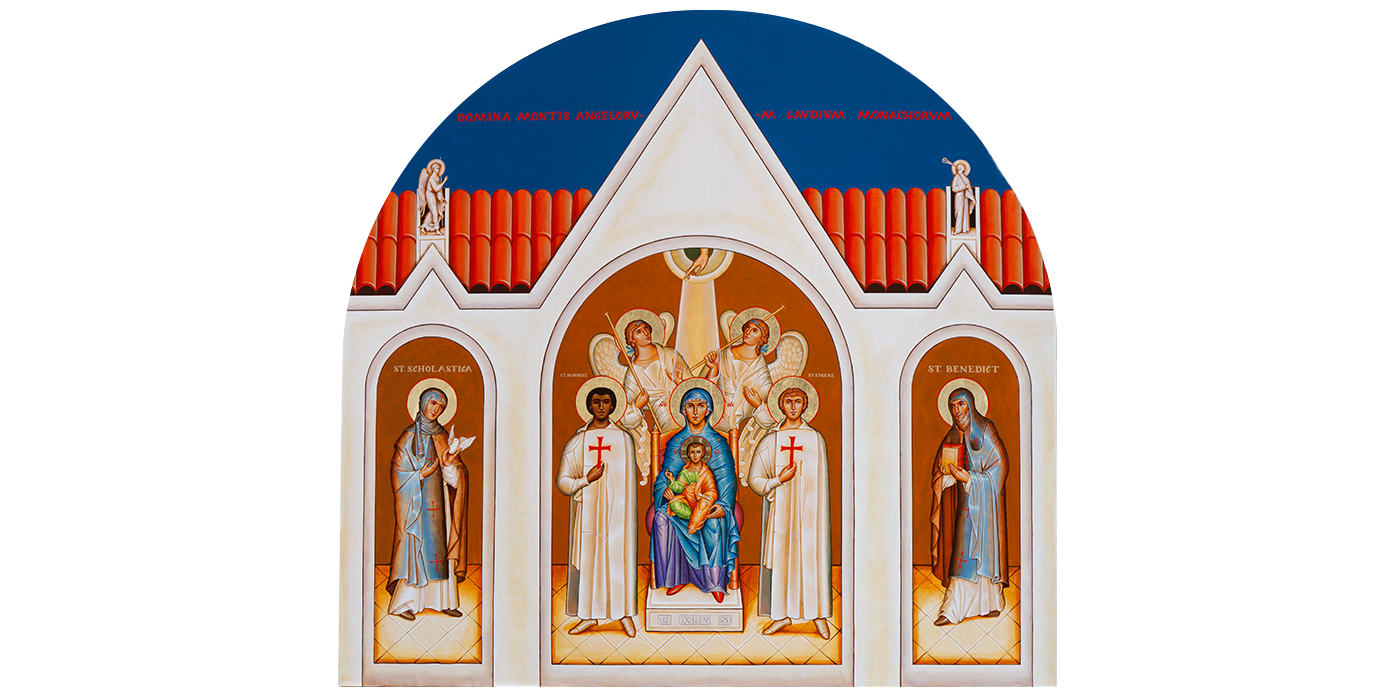
Mary, Joy of Monks
Monastery Refectory | 89″ x 92.5″
The center panel depicts Mary with the child Jesus sitting on her lap. To their left and right are Sts. Eugene and Maurice, minor patrons of Mount Angel, flanked by two angels. God’s hand is seen above Mary, and His blessing is shining down on her. To the left is St. Scholastica, with a dove in her hand, a symbol of her soul which St. Benedict saw rising to heaven. In the right panel, St. Benedict is shown, with a book in his hands. On the roof of the structure are sculptures of St. Michael the Archangel and St. Joseph, strong patrons of Mount Angel. It is to Mary, Joy of Monks, that the Salve Suite is dedicated.
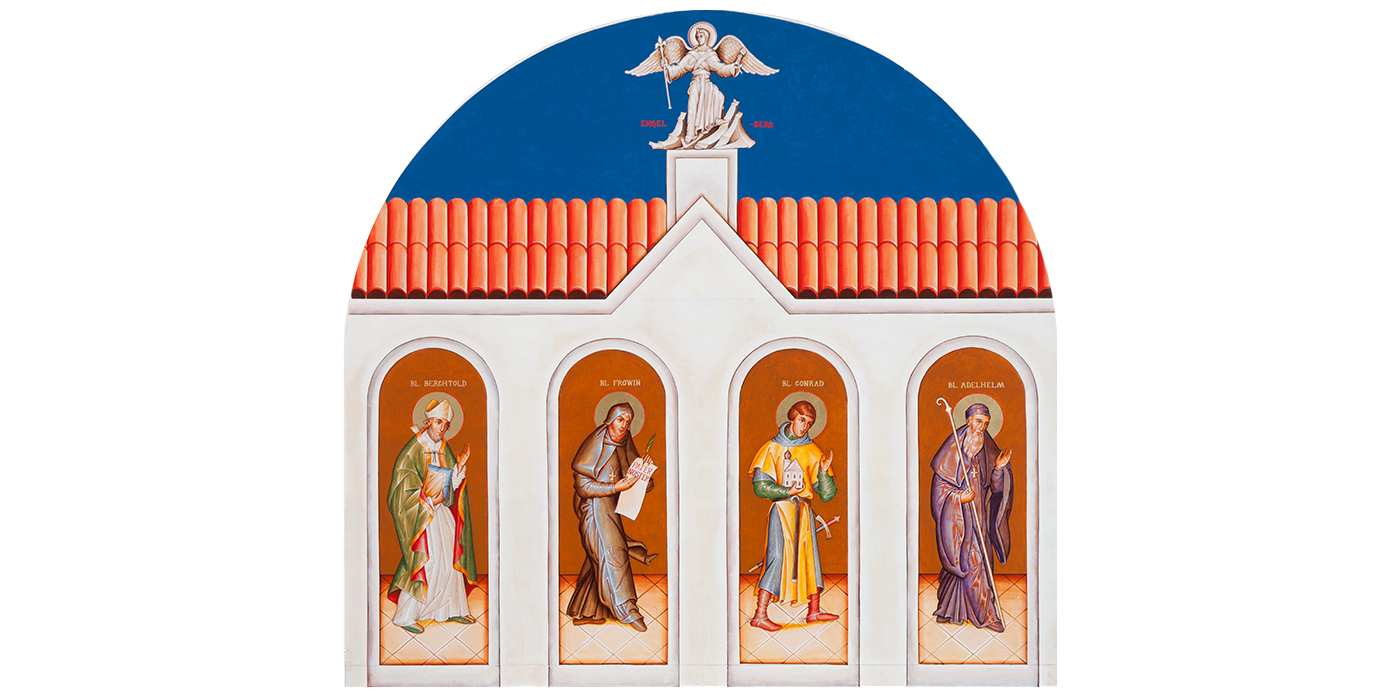
Four Blessed of Engelberg
Monastery Refectory | 89″ x 92.5″
This icon/mural depicts the four Engelberg founders upon whom we rely for spiritual support and protection: Bl. Berchtold, dressed in green as a bishop with a book in his right hand; Bl. Frowin, in the monastic habit, with pectoral cross, holding a quill and parchment, which says Pater Noster; Bl. Conrad, dressed as a crusader, and holding a church in his right hand; and Bl. Adelhelm, dressed as an abbot, with pectoral cross and crosier. The angel of Engelberg is shown on the roof of the structure, which resembles the current (3rd) monastery of Mount Angel.
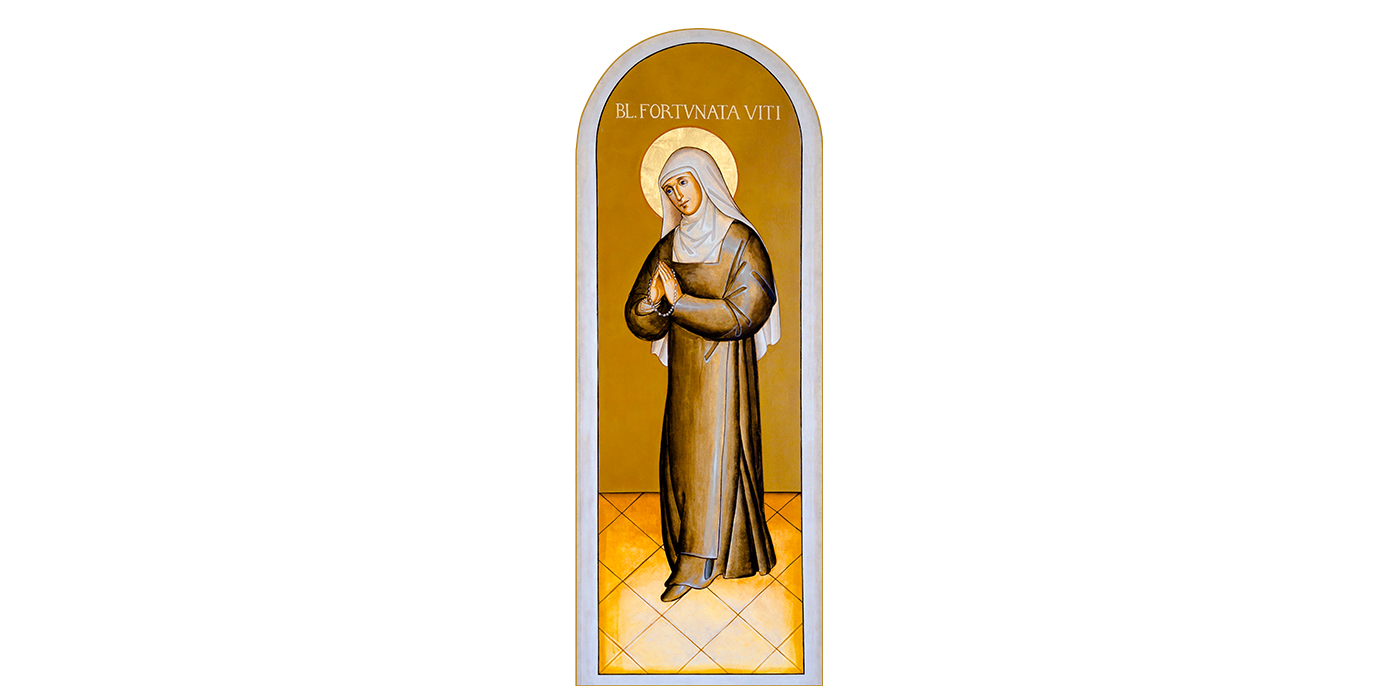
Blessed Fortunata Viti
Monastery Refectory | 17″ x 46.5″
A monk of Mount Angel Abbey has been postulator for her cause for sainthood for many years. The icon depicts the Italian Benedictine nun Blessed Fortunata Viti, a 19th century member of the monastery San Maria de Franconi, in Veroli, Italy. She lived a simple life and a holy life. While she lived in the era of photography, no known photos of her exist; only a single painting exists of her, on which this icon is based. Maria Fortunata was a lay nun, not a choir nun, so she is depicted wearing the white veil proper to her station, not the black veil.
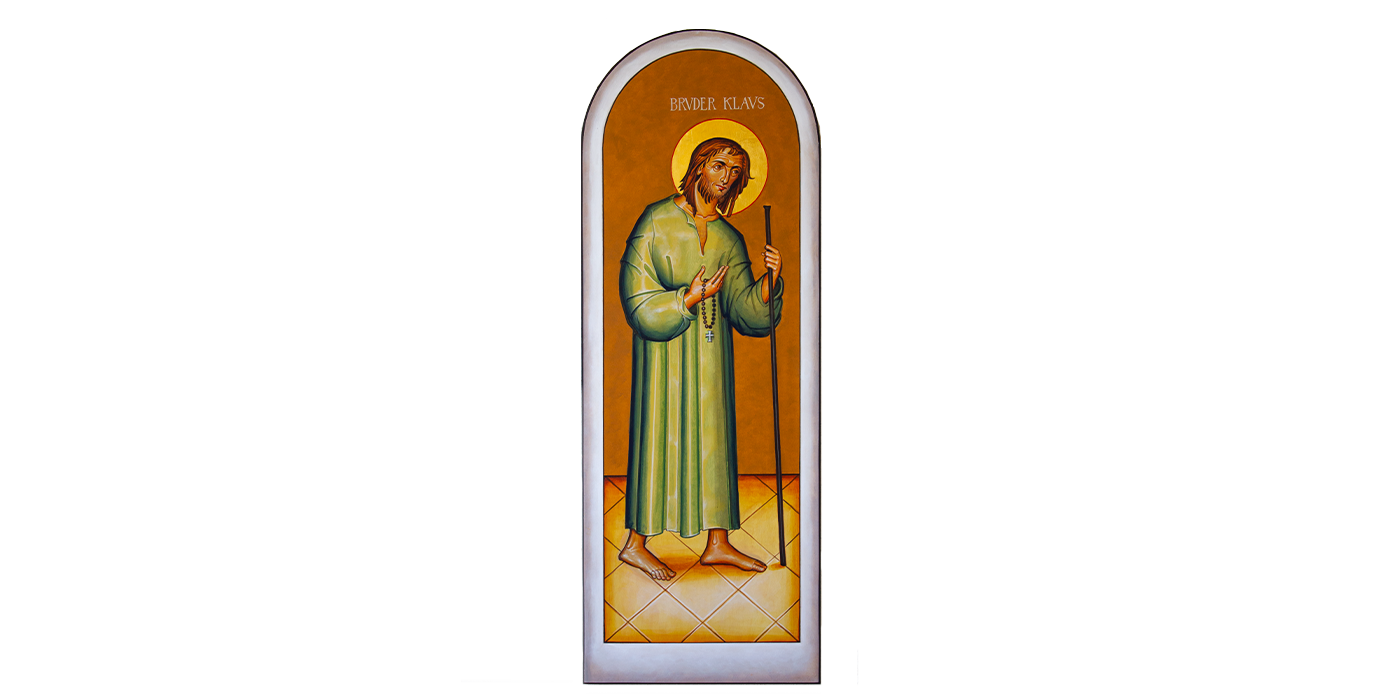
St. Nicholas de Flue
Monastery Refectory | 17″ x 46.5″
An icon of the Swiss hermit St. Nicholas de Flue, known familiarly as Bruder Klaus, patron of Switzerland, and a major patron of Mount Angel Abbey’s motherhouse, Engelberg Abbey. He is always pictured with his rosary and staff in hand, wearing the simple pilgrim’s tunic and with bare feet. His slightly emaciated appearance is indicative of his 20-year fast, existing on nothing but the Eucharist as recounted in the story of his life.
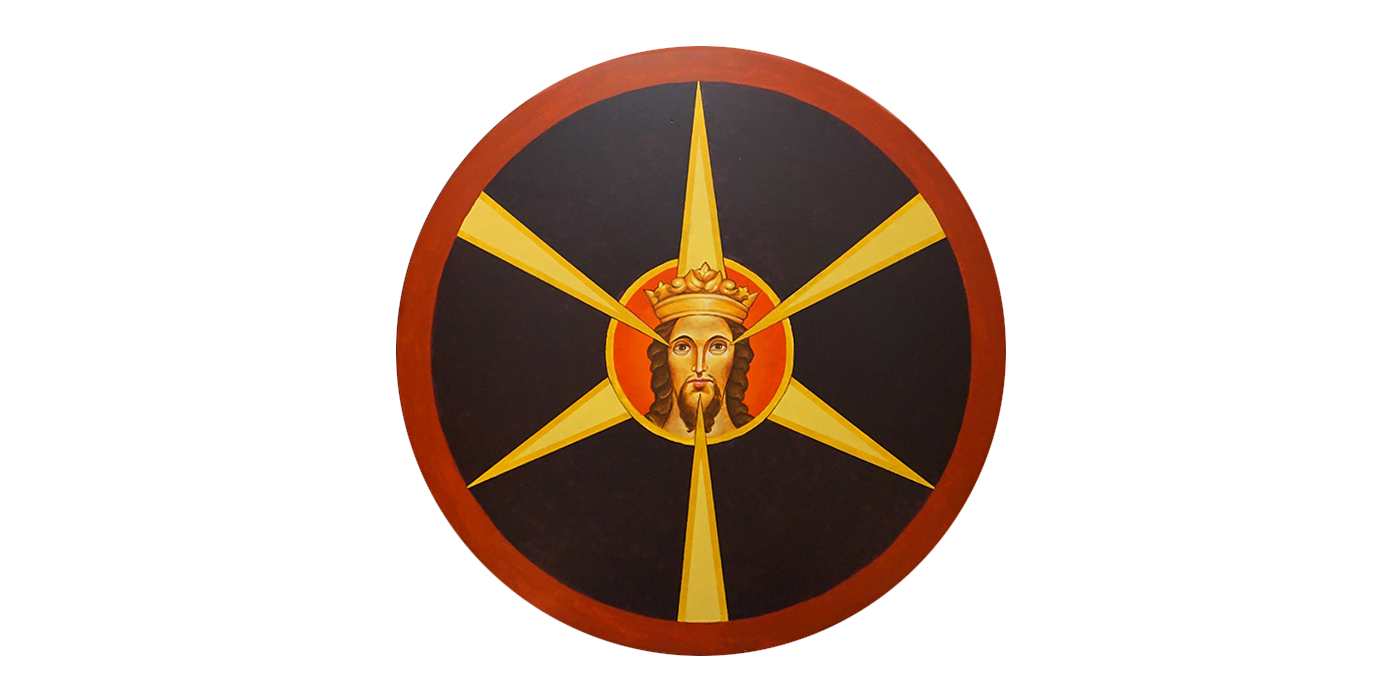
Vision of St. Nicholas de Flue
Monastery Refectory | 36″ diameter
Iconic depiction of a vision reported by Swiss hermit St. Nicholas de Flue (Bruder Klaus) of the divine Godhead. This depiction would be well-recognized in Swiss churches. The original still hangs in his old hermitage near Engelberg. The image is composed of three rays pointing inward and three pointing outward, symbolizing the inner relationship of the Trinity. The face of God, which looks like Christ because Christ is the only way we know what God looks like, is set on a field of black, the uncreated light.
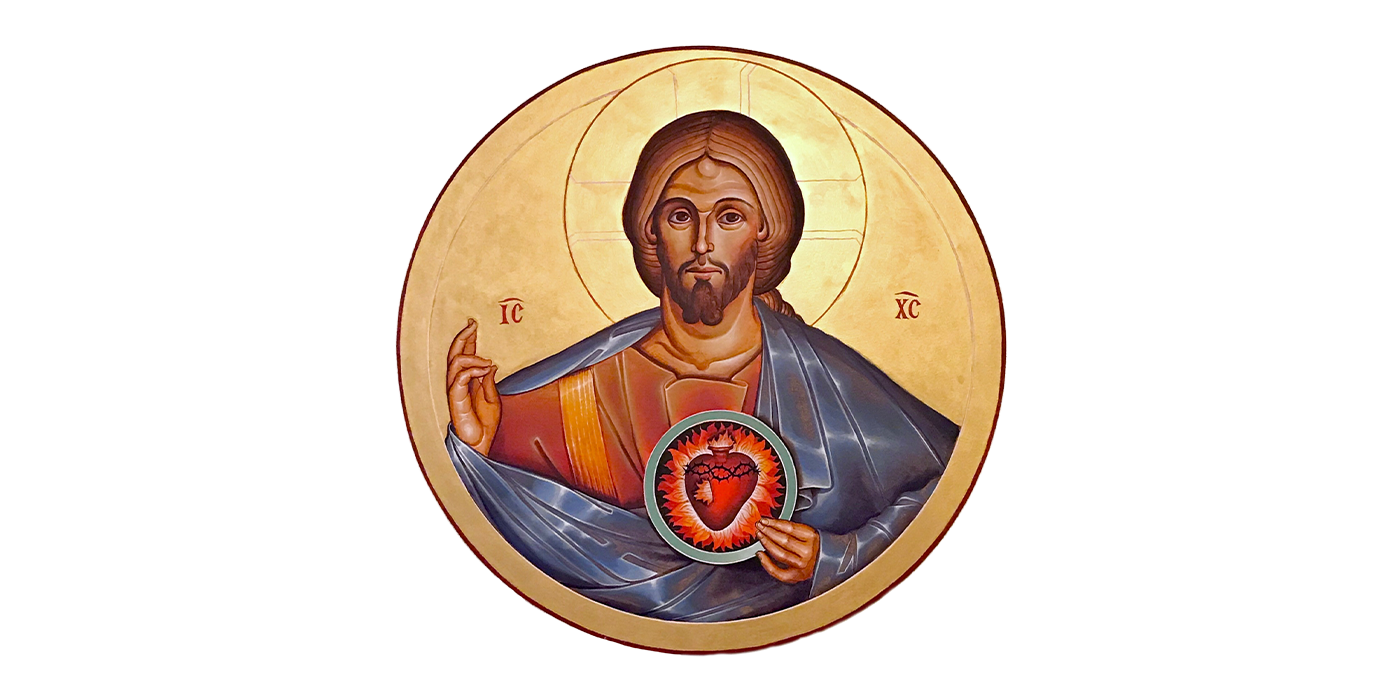
Heart of Christ
Monastery Chapter Room | 36″ diameter
This image was chosen for the Chapter room of the monastery because it is here that wisdom, mercy, and good counsel must be exercised by all the monks. All are found in abundance in the Heart of Christ. The icon of the Heart of Christ is set against a gold leaf background and follows standard western Sacred Heart conventions which always emphasize the Divine Mercy of Christ.
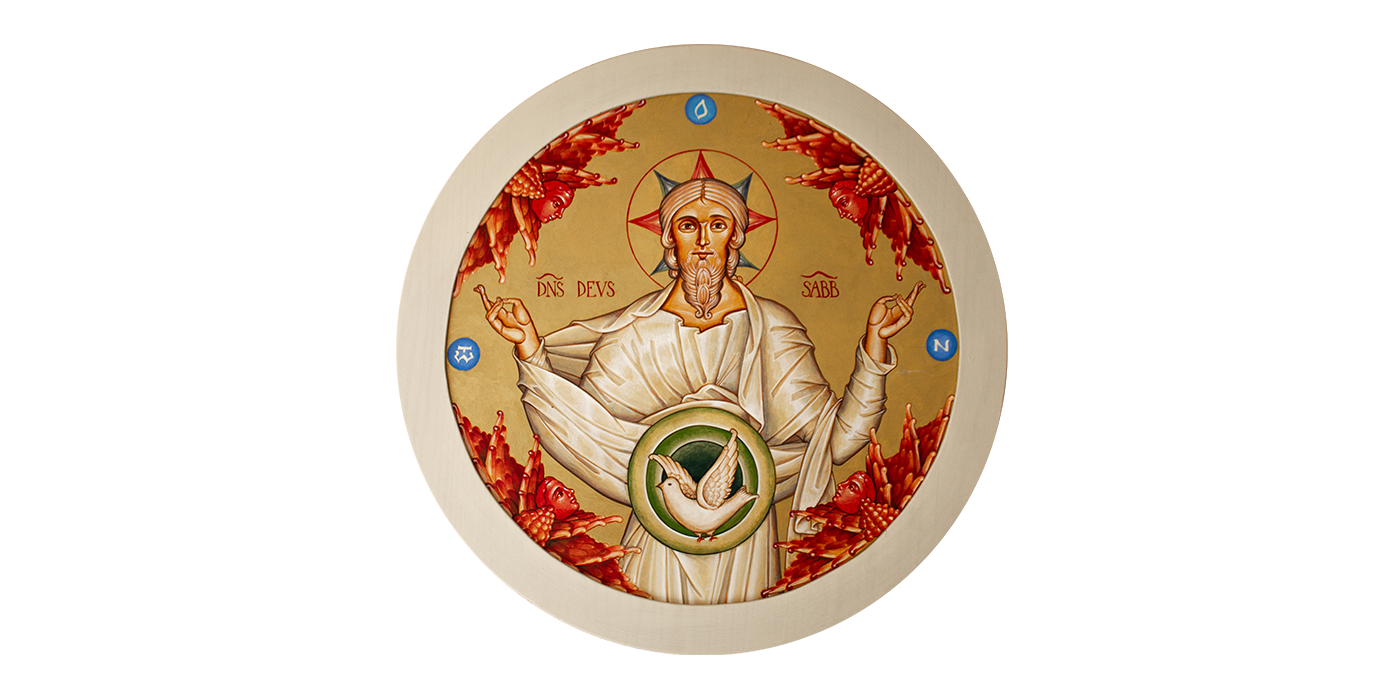
Dominus Deus Sabaoth
Cloister Hall | 27.75″ diameter
An icon of God the Father, reigning in heaven, with the Holy Spirit shown as a dove in a mandorla in front. The Father is the central focus of the other two icons, St. Michael and St. Joseph, who are looking at the Father but whose bodies are turned the opposite direction, with only the Christ Child in St. Joseph’s arms looking directly at the Father. The six-winged seraphs at the four corners evoke the image of God appearing in the burning bush. (1/3)
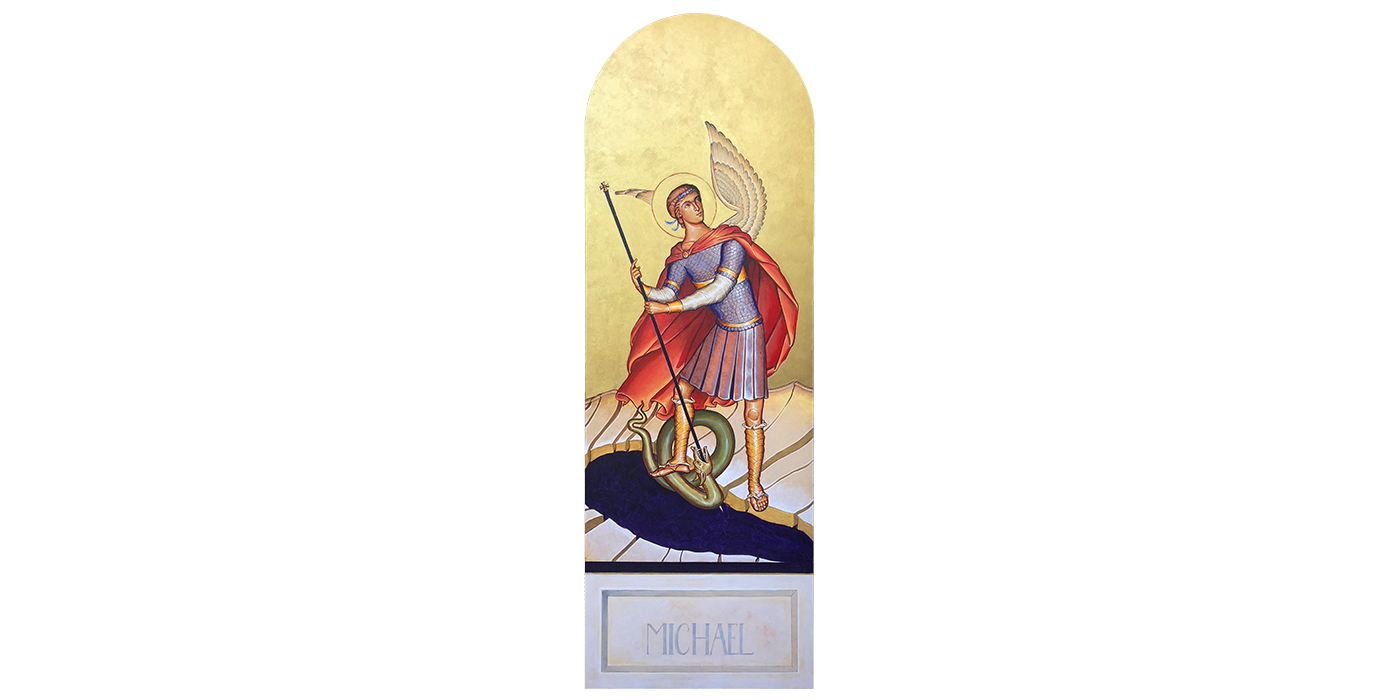
St. Michael the Archangel
Cloister Hall | 24″ x 70″
St. Michael and St. Joseph have been two of the Abbey’s principal patrons from the beginning, each being depicted on the front of the Abbey church. This piece is a large icon depicting St. Michael the Archangel, dressed in military garb and a red cape to symbolize his station of leading the armies of angels against Satan and his cohort, slaying the serpent with his spear, and forcing him down into the dark pit. (2/3)
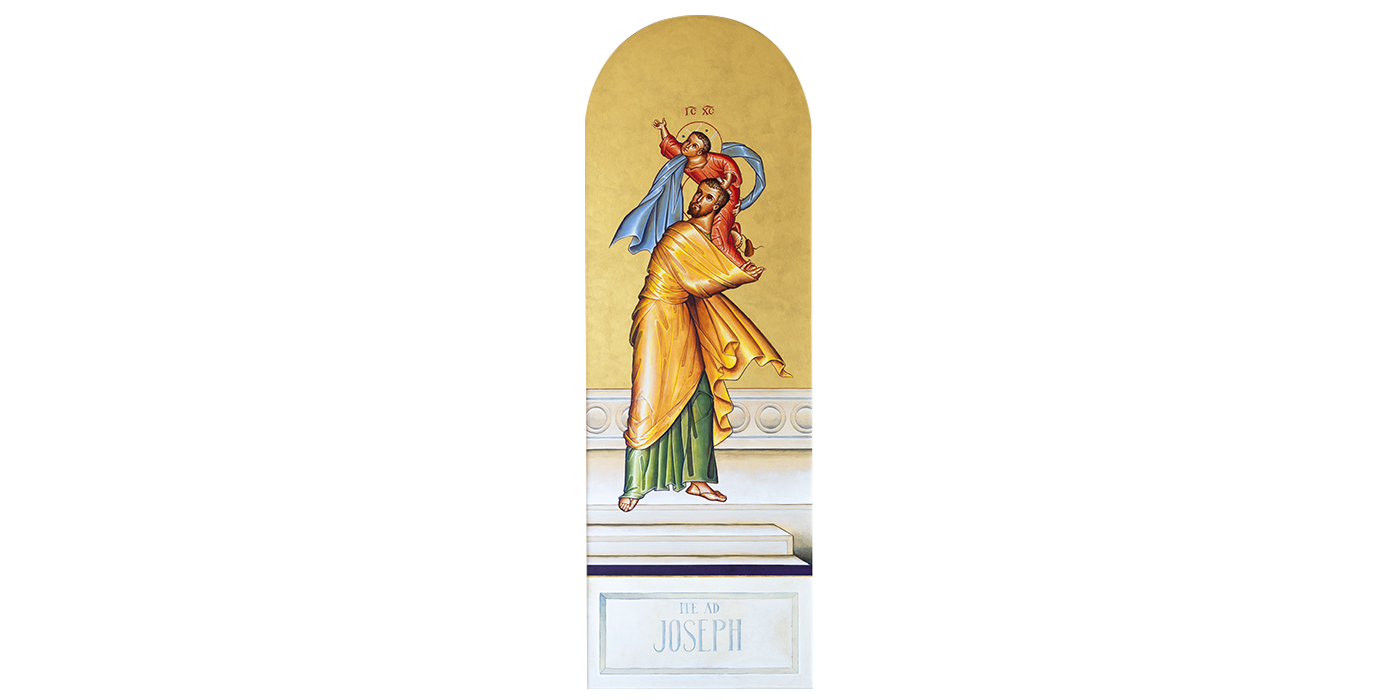
St. Joseph Protector
Cloister Hall | 24″ x 70″
An icon of St. Joseph, “foster father of the Son of God” and principal patron of Mount Angel Abbey. St. Joseph lifts the Christ Child up over his shoulder, where Christ reaches toward his Heavenly Father, who is in the paired icon of Dominus Deus Sabaoth. With the breeze visibly blowing St. Joseph’s cloak, there is a hint of the presence of the Holy Spirit as well. (3/3)
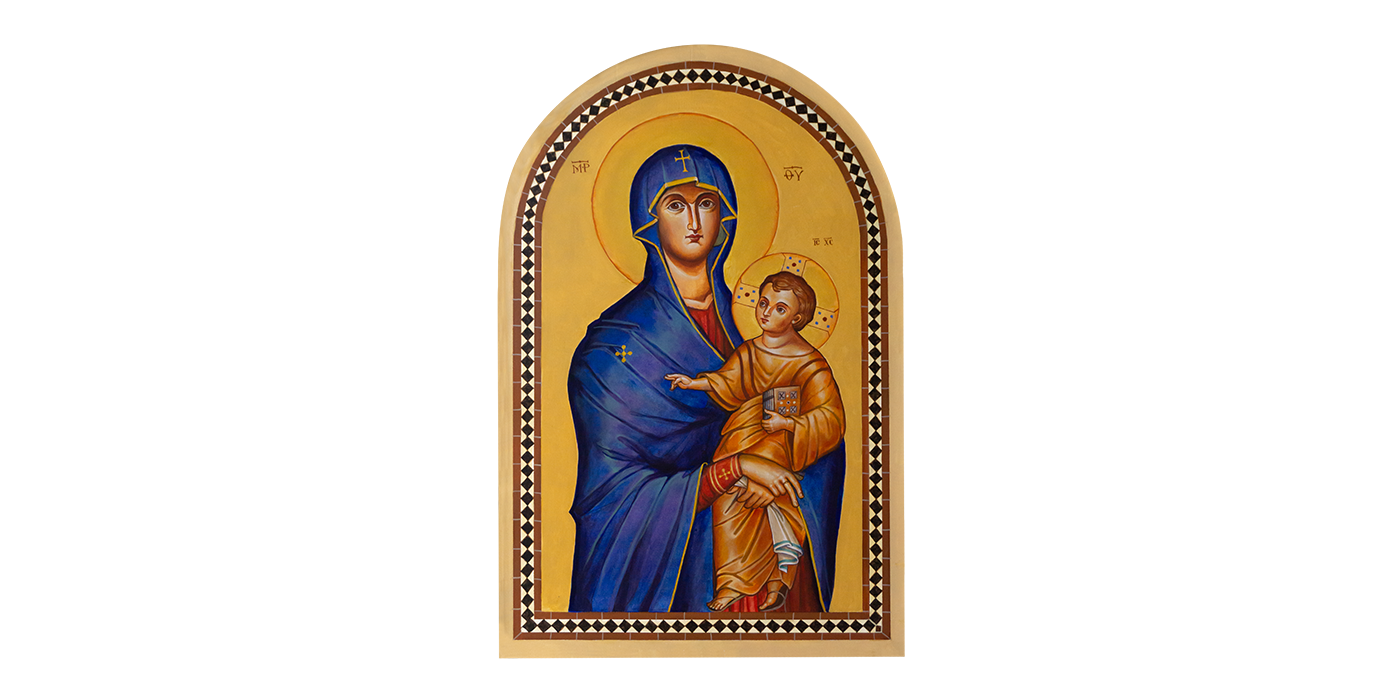
Salus Populi Romani
Monastery Infirmary Chapel | 24″ x 36″
This icon was written in response to the COVID-19 pandemic, to implore Mary’s protection on the monastery and surrounding areas against this and all other plagues. The original is from the 7th century. Having traveled from Byzantium, up the Tiber, and finally to Rome, it was received by Pope Gregory the Great. Not long after, a plague broke out. Earnestly praying to Our Lady, the plague abated, and the painting received its current name, Our Lady, Salvation and Health of the People of Rome.
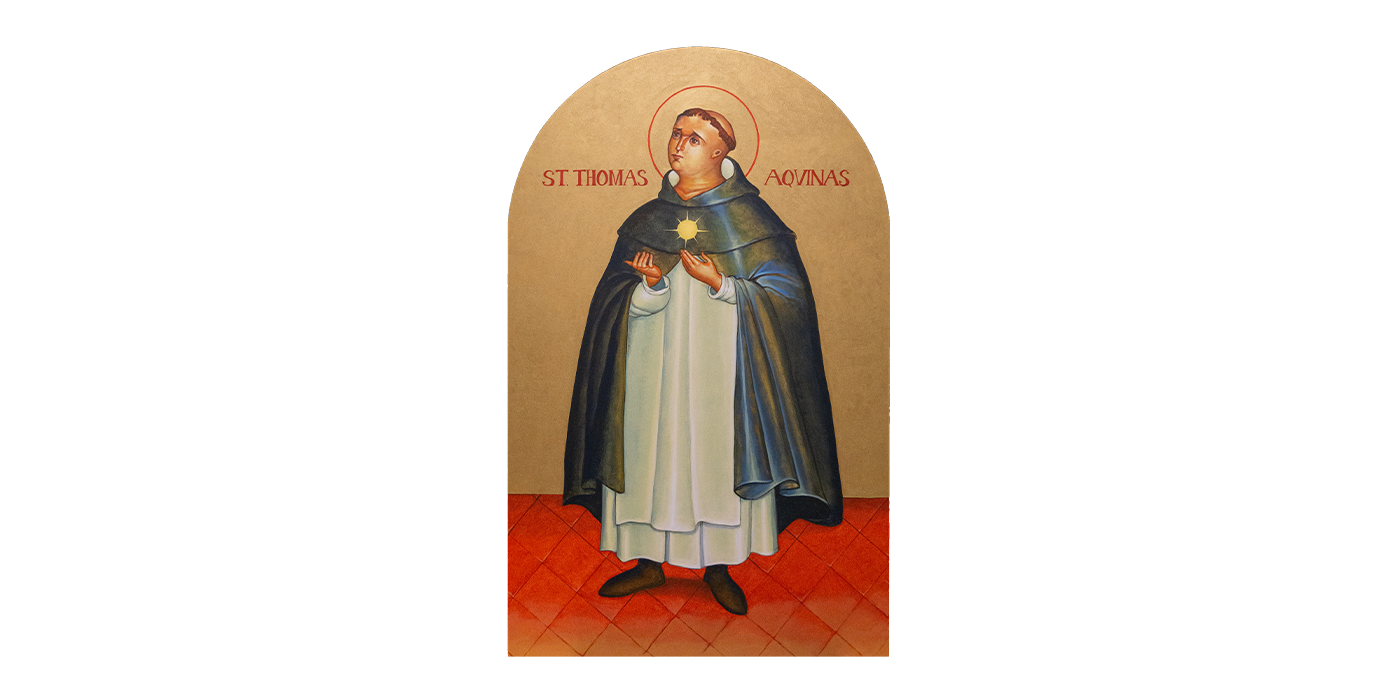
St. Thomas Aquinas
St. Thomas Aquinas Graduate Seminary Hall | 36.5″ x 54″
When the graduate seminary was first opened in 1889, it was placed under the patronage of St. Thomas Aquinas, the Angelic Doctor of Theology. This icon depicts the 13th century Dominican and Doctor of the Church. He wears the full Dominican habit and cappa (cape). The sunburst on his breast symbolizes his theological writings, illumined by the Light of Truth. Traditionally, it may also refer to his fire of charity or his angelic purity.
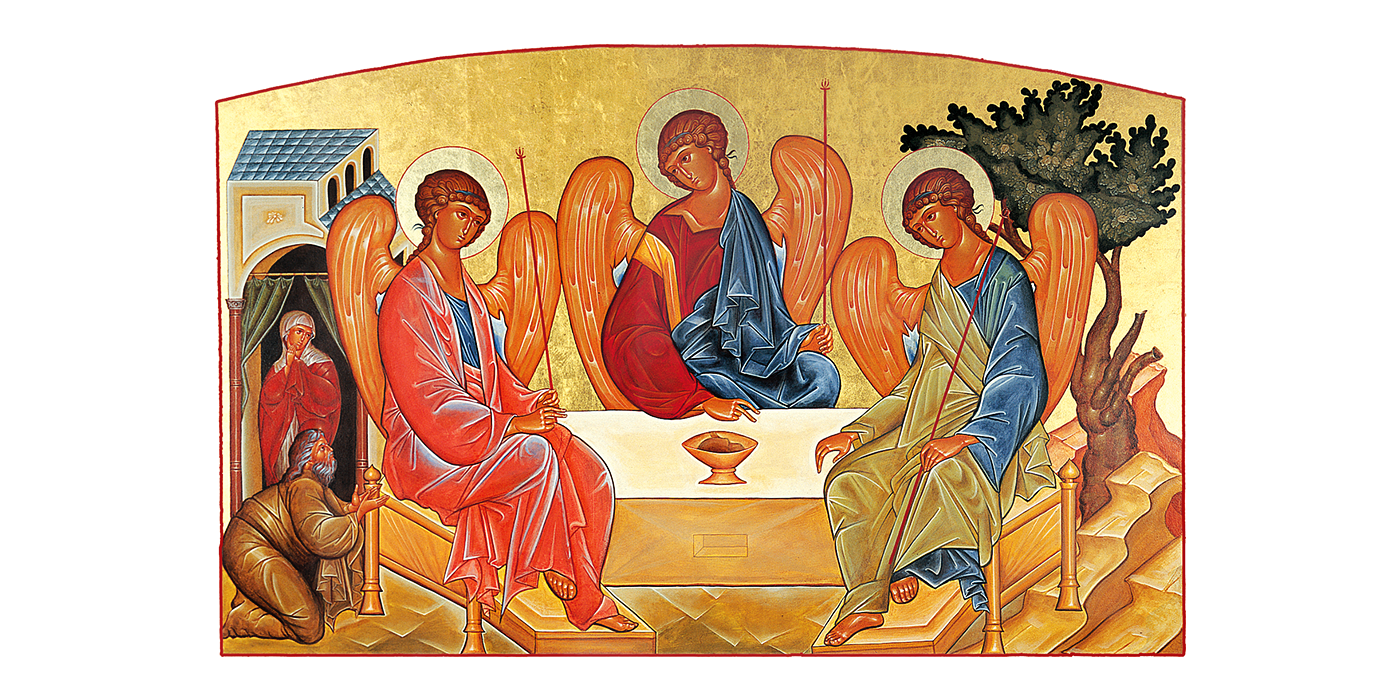
Abraham’s Hospitality
Seminary Dining Room | 107″ x 71″
This icon takes as its subject the mysterious story of Abraham’s hospitality to three visitors by the Oak of Mamre, as told in Genesis 18, with a strong Eucharistic theme. Three gold-winged figures are seated around a white table on which Abraham serves a meal in a golden, chalice-like bowl containing a roasted lamb of sacrifice. As the conversation progresses, Abraham seems to be talking directly to God, as if the “angels” were in some way a metaphor for the three persons of the Trinity. The composition forms a great circle around the table, focusing attention on the central chalice-like bowl, which reminds the viewer inescapably of the altar of communion. Reading the picture from left to right, we see the Father, the Son, and the Holy Spirit. Interestingly, Sarah is shown laughing in the background at the prospect of bearing a child in her old age.
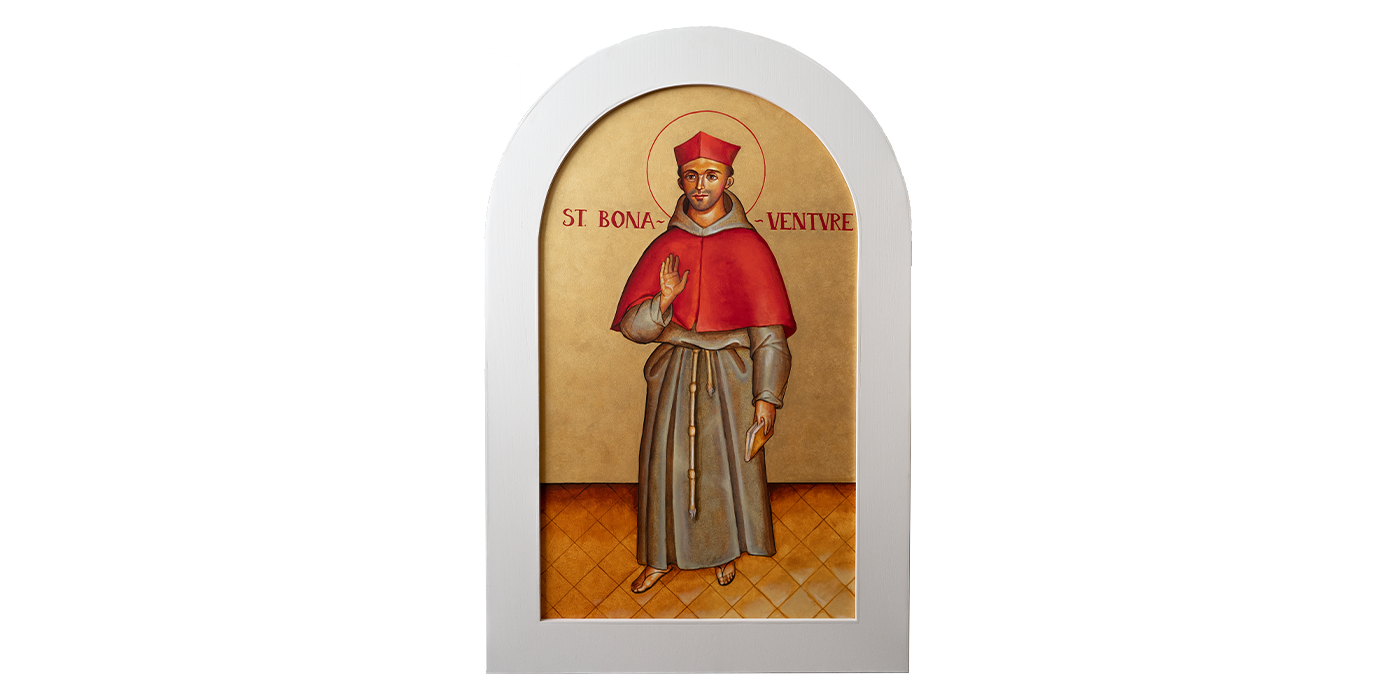
St. Bonaventure
Mount Angel Abbey Library | 24″ x 40″
An icon depicting the renowned Franciscan friar, cardinal, Doctor of the Church, and prolific writer, St. Bonaventure. He is shown wearing a traditional brown Franciscan habit with a triple-knotted rope cincture and the cardinal’s red biretta and mozzetta. The book he holds in his left hand is a sign of his great contribution to philosophy and theology, and his right hand is raised in an open sign of blessing.
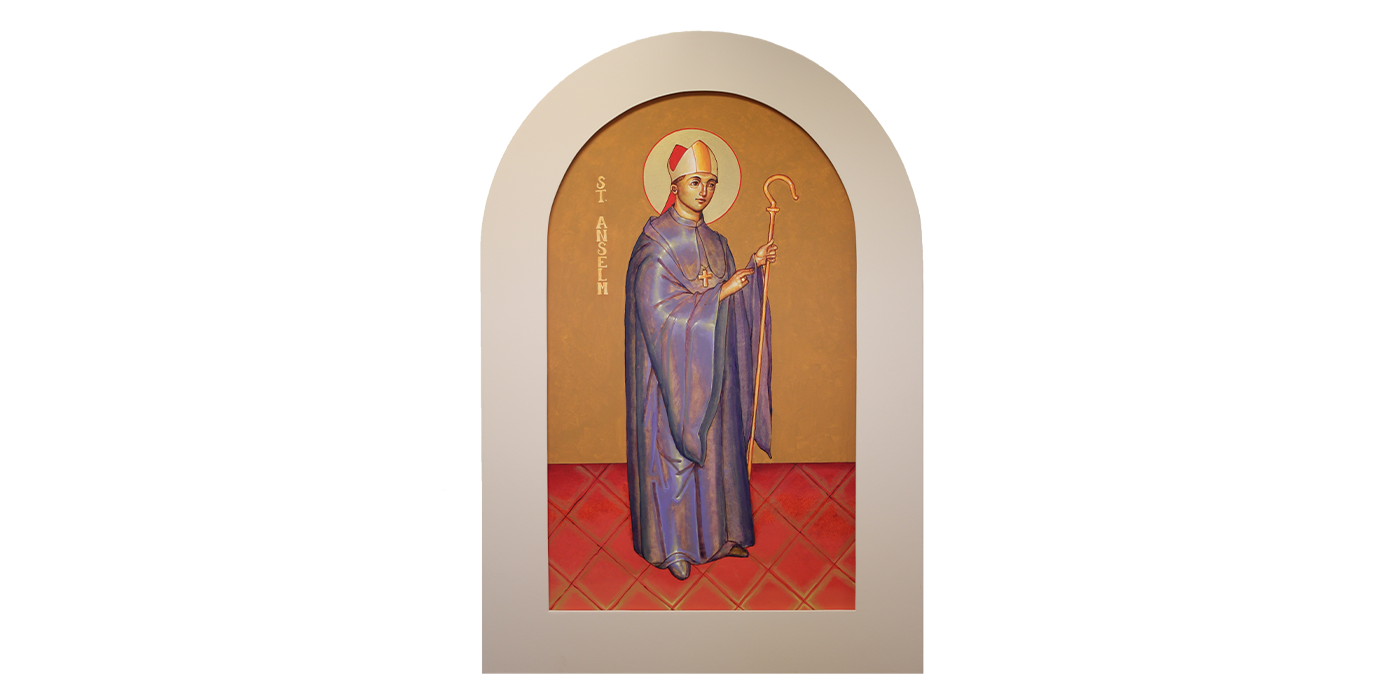
St. Anselm of Canterbury
St. Anselm Undergraduate Seminary Hall | 23.25″ x 38.5″
When the undergraduate seminary was first opened in 1889, it was placed under the patronage of St. Anselm of Canterbury, Doctor of the Church and preeminent philosopher. The icon depicts St. Anselm as a Benedictine monk of the Abbey of Bec, who was eventually named the Archbishop of Canterbury. The icon depicts both of these vocations as he wears his monastic cuculla but also bears the episcopal crosier, pectoral cross, ring, and mitre. Part of his accepting the office of bishop involved King William II accepting the Gregorian reform and returning Church lands which he had seized for the state. St. Anselm must also have been more than a bit of a diplomat. The gold of his halo draws the viewer to a deeper look through this heavenly window.
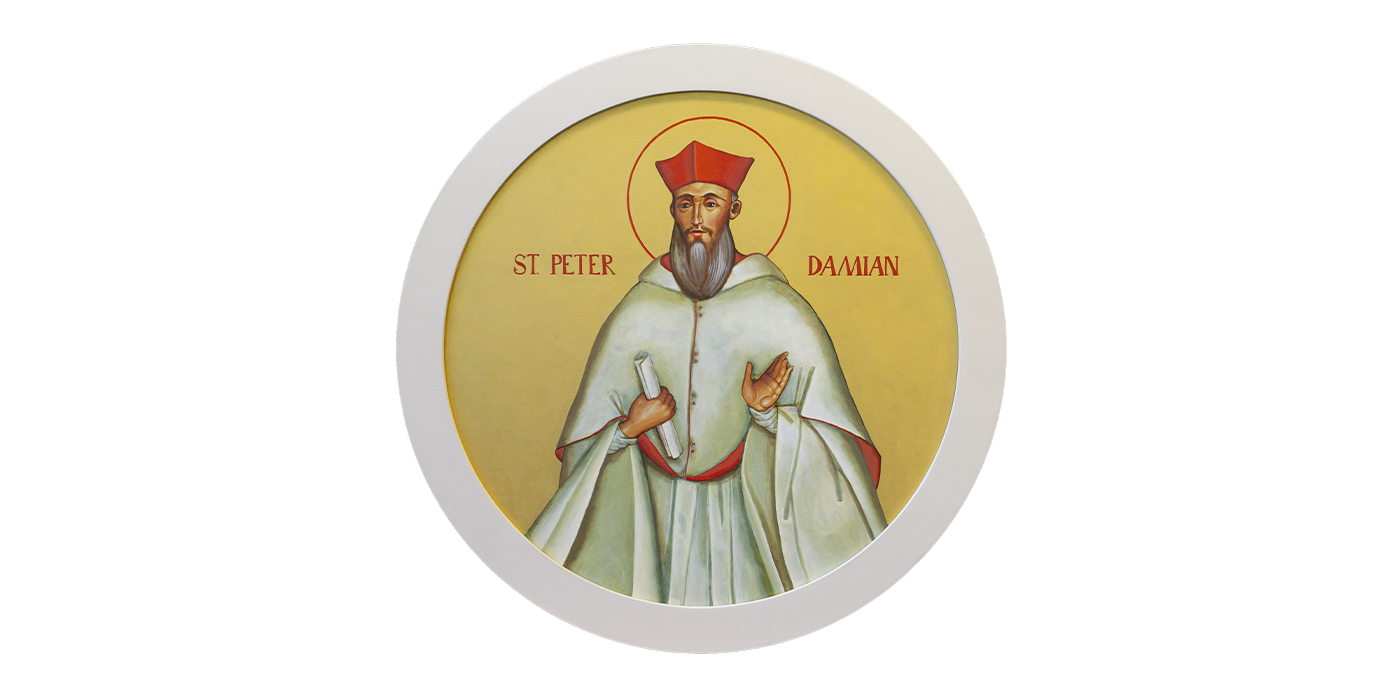
St. Peter Damian
St. Peter Damian Center | 32″ diameter
St. Peter Damian was a great Benedictine aesthetic. He was also a renowned canon lawyer who, having been poor as a child, maintained a special concern for the poor throughout his lifetime. The icon depicts the great reforming monk and cardinal. He was active during the 11th century, serving first as a reformer of his own priory and then for the Curia in Rome when he was elevated to and, after some resistance, finally accepted to the cardinalate under Pope Stephen IX, former abbot of Monte Cassino. He is depicted here in a cardinal’s formal attire, white with red piping and biretta.
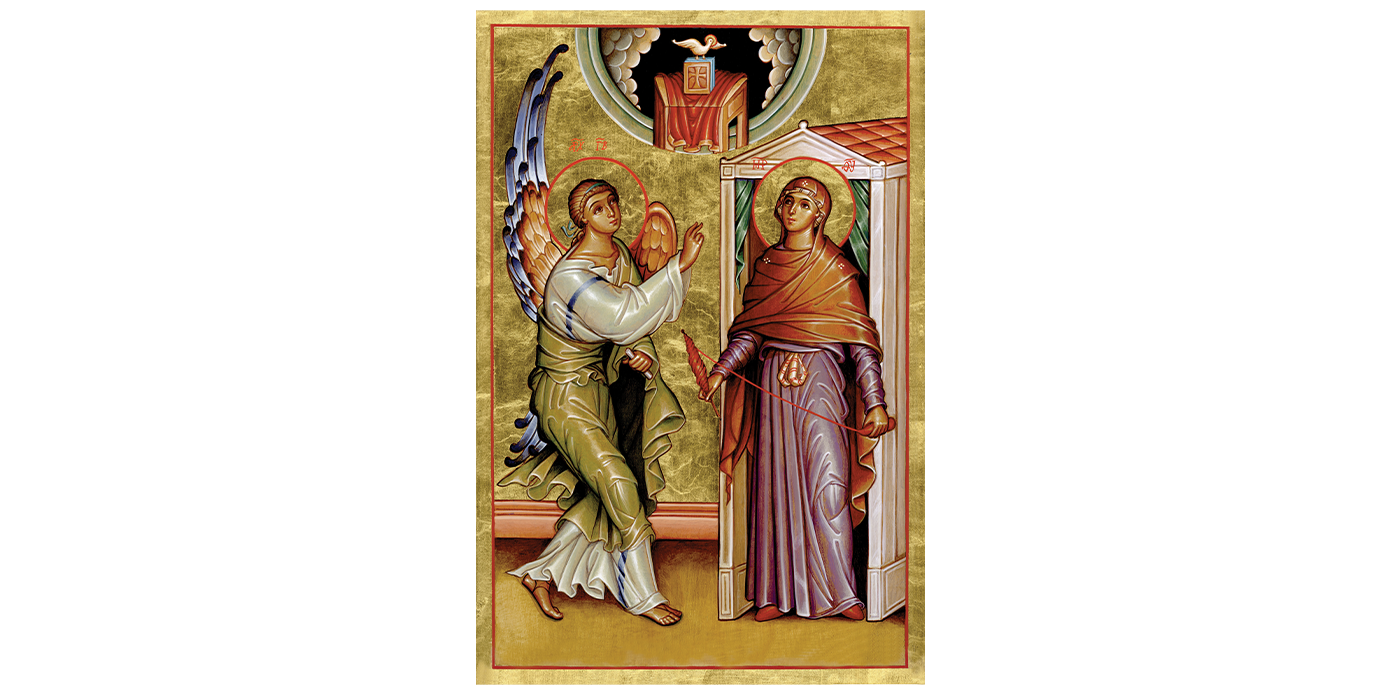
The Annunciation
Cloister Hall / Seminary’s Annunciation | 11.5″ x 17.5″
The seminary’s theology classroom building is dedicated to the mystery of the Annunciation. In this image, the Archangel Gabriel announces to Mary that she is to bear a son by the Holy Spirit. Gabriel’s stance indicates action – the message he swiftly bears – while Mary’s shows openness to receiving the message of God’s will. The Trinity is depicted above in the iconographic style known as “The Prepared Throne.” God the Father is the empty throne on which no one is sitting, but he is revealed through his Word, portrayed as the book, and the Holy Spirit flows out from them as a dove. This icon served as the model for the monumental mosaic, created by Lynne Chinn, in the entry of the Annunciation building.
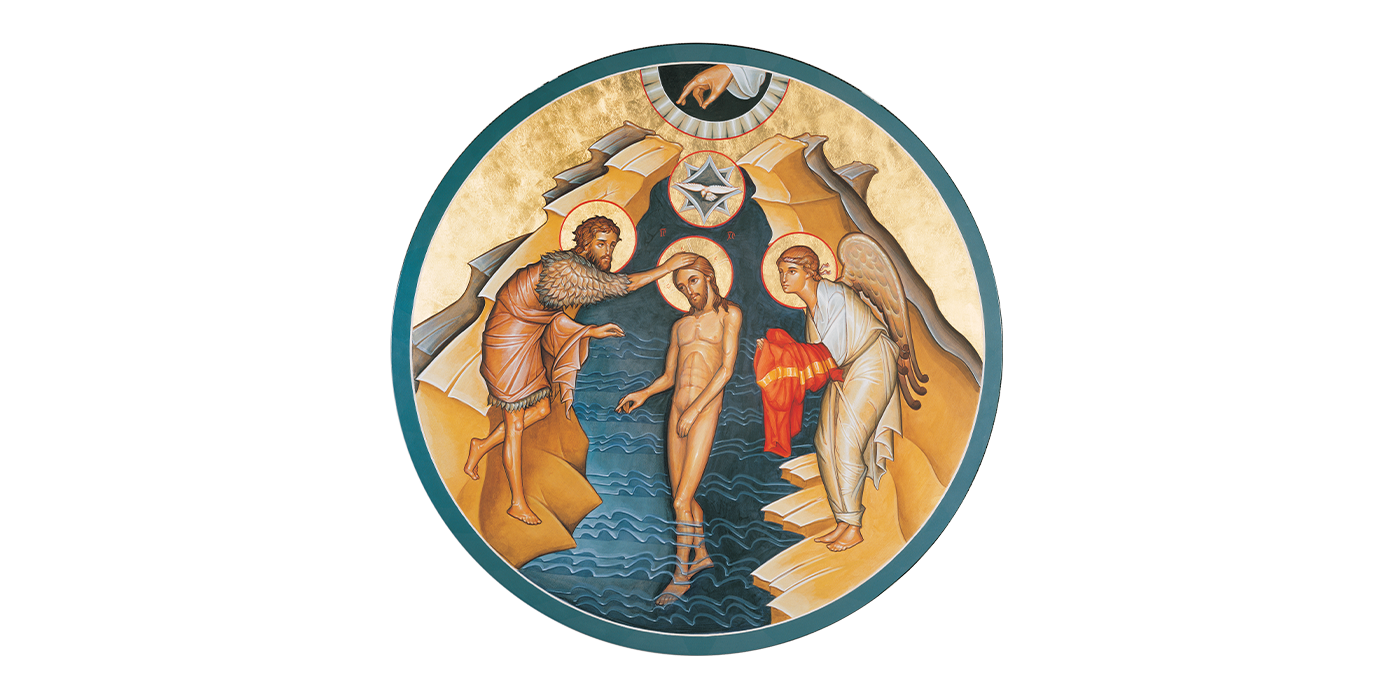
The Baptism of Jesus
Saint Benedict Guesthouse and Retreat Center | 36″ diameter
One of three icons of the Suite in the Saint Benedict Guesthouse and Retreat Center. The Baptism of Jesus icon represents reconciliation and new life in Christ. The circular icon depicts Jesus being baptized in the Jordan River by St. John the Baptist. An angel holds Jesus’ red and gold-striped tunic, representing his humanity and divinity, respectively. The Holy Spirit in the form of a dove is seen resting over Jesus’ head, and the hand in the sky within the round mandorla represents the Father in heaven, “well pleased” with his Son.
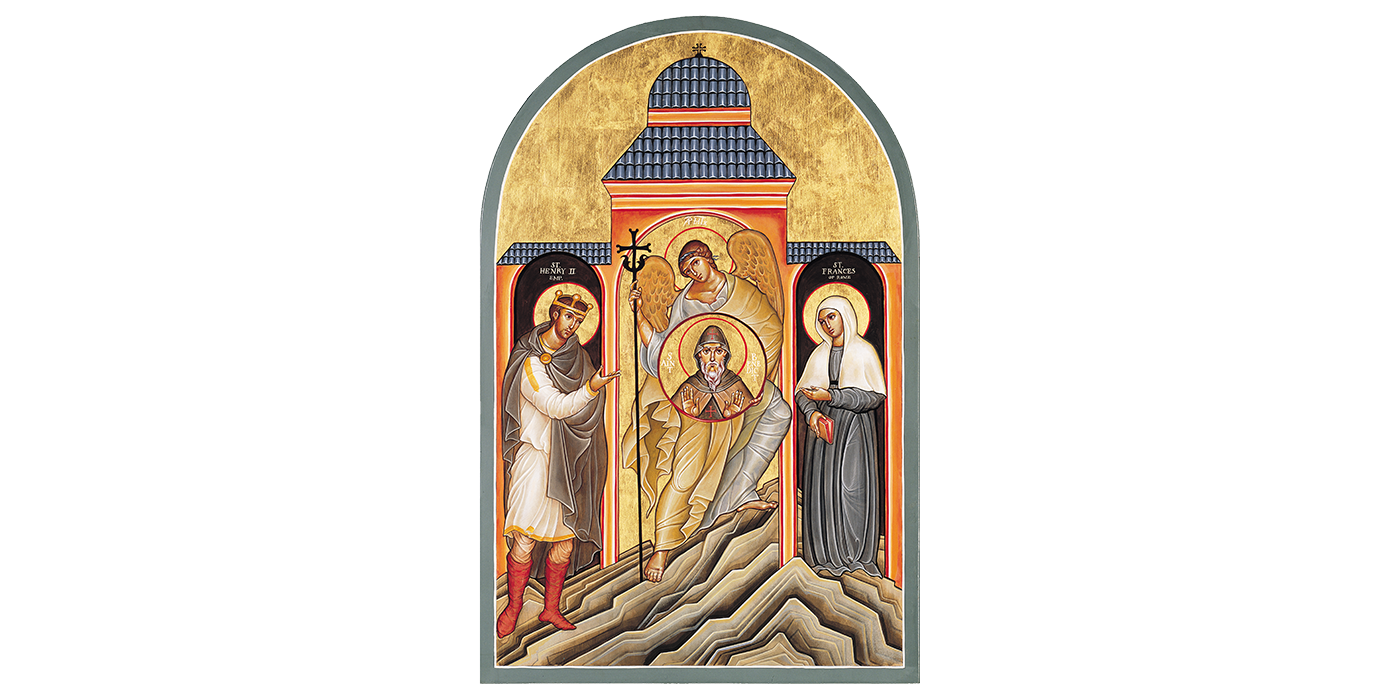
St. Henry & St. Frances of Rome
Saint Benedict Guesthouse and Retreat Center | 25″ x 37.75″
This icon depicts the two Benedictine oblate patrons, St. Henry II and St. Frances of Rome. There is an angel between them, holding the image of St. Benedict. Asianic architecture was used in this icon as a particular stylistic choice by Br. Claude at the time, more of a personal flair than theological significance. The Abbey entrusts the care of our oblates to St. Benedict and these patrons of all Benedictine oblates.
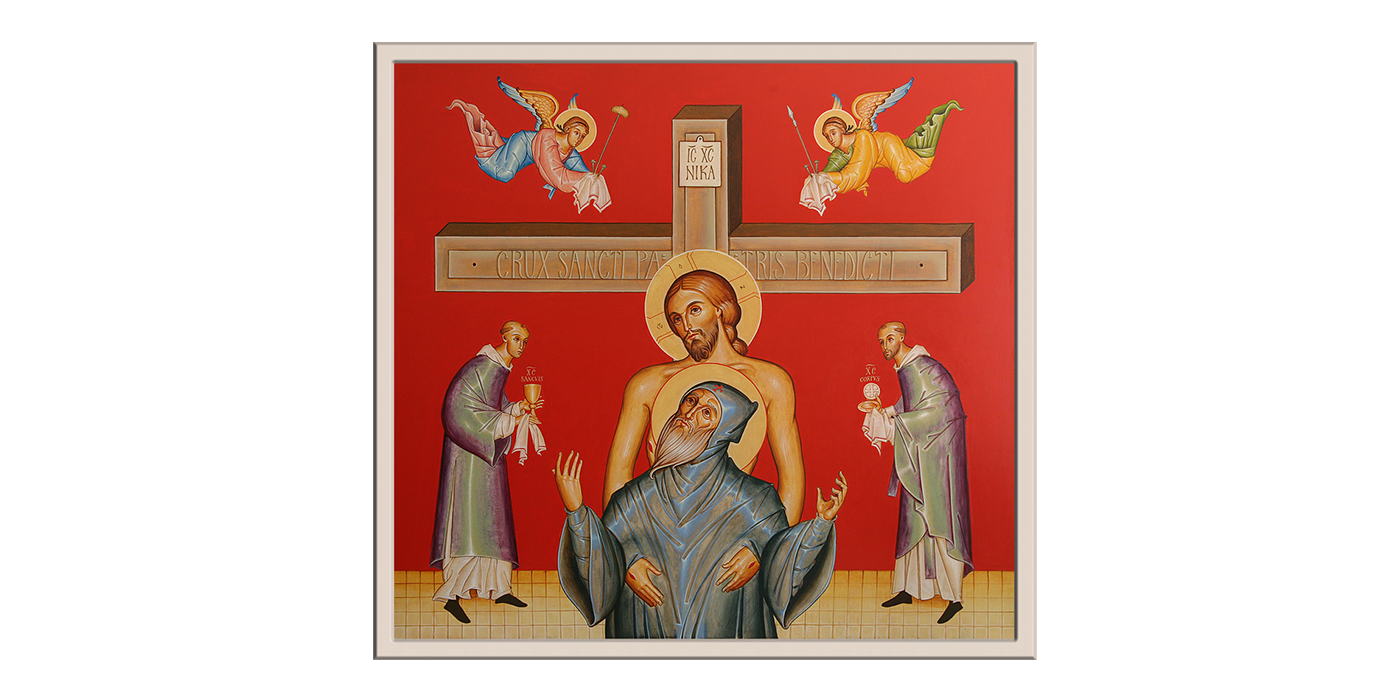
Passing of St. Benedict
Saint Benedict Guesthouse and Retreat Center | 44.75″ x 41.5″
The entire Abbey is dedicated to St. Benedict and relies on his spiritual guidance and protection. Here we see St. Benedict as an old man at his death, as described in St. Gregory’s Dialogues: his arms are raised in prayer, with the crucified Jesus holding him up. The cross is pictured behind them, inscribed with the Christogram ICXC NIKA and the beginning of the St. Benedict prayer, Crux Sancti Patris Benedicti. A priest and deacon are to the right and left, offering the viaticum of the Body and Blood of Christ. Angels above them hold the tools used in the crucifixion: the nails and lance, and a sponge soaked with vinegar on a spear tip.
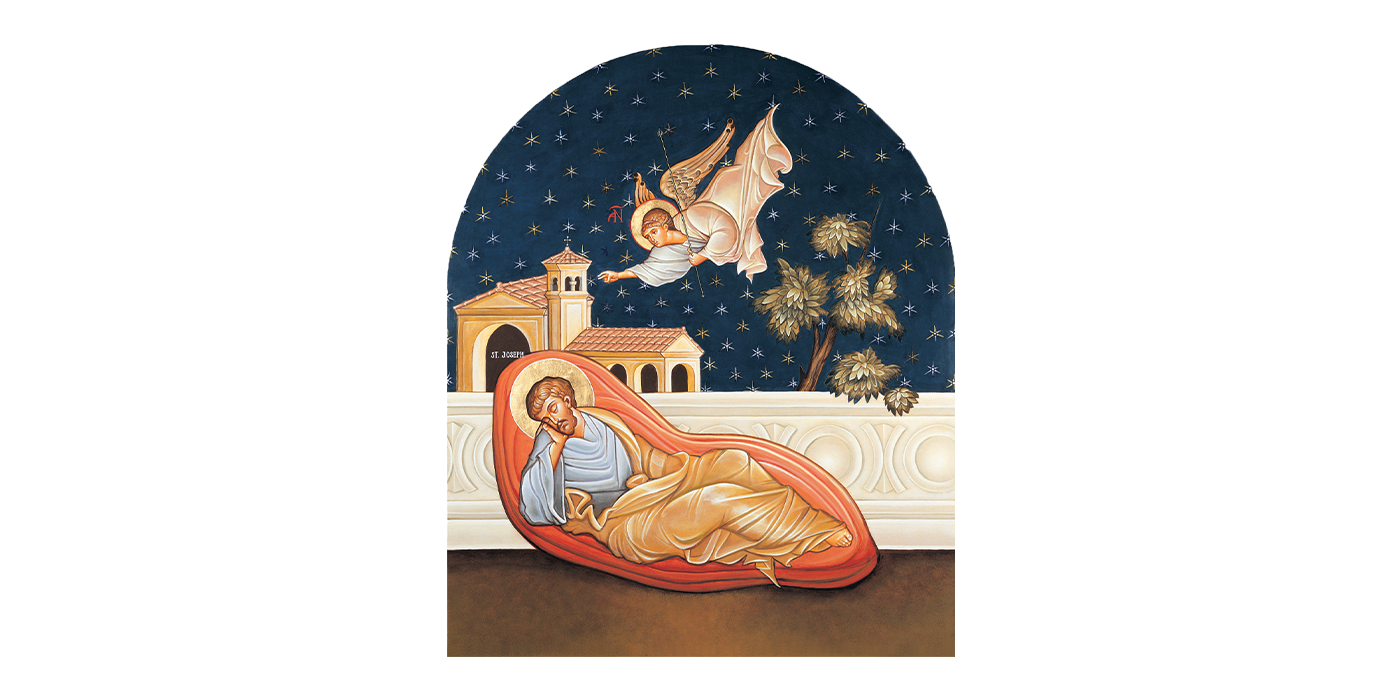
Annunciation to St. Joseph
The Seminary’s St. Joseph Chapel | 46″ x 54″
From the earliest days of our monastic community, we have had a strong devotion to St. Joseph as one who secures our temporal needs. He is also the model of a good and faithful man. The icon depicts the sleeping St. Joseph, receiving the vision of an angel while he sleeps. The angel is depicted above him with staff in hand, telling him not to be afraid to take Mary into his home. There is a building, a starry night sky, and the branch of a tree behind him. The architecture is based on Mount Angel Abbey.
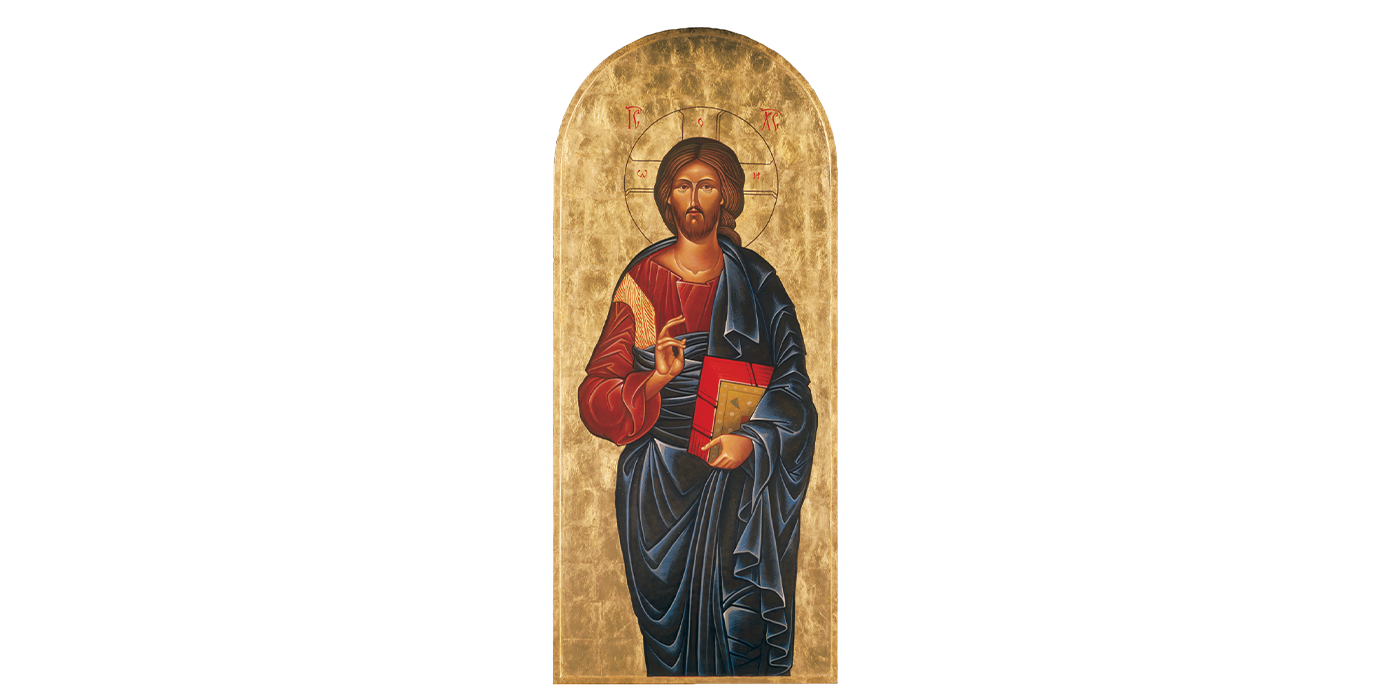
Christ the Teacher
Abbey Church Above the Tabernacle | 20″ x 59.75″
We end where we began, with Christ the Teacher. While this icon depicts a more traditional Pantocrator, a rendering of Christ in the Eastern traditions as the almighty or all-powerful, at Mount Angel it has taken on the name of Christ the Teacher, possibly due to the academic environment of the seminary. Besides being one of Br. Claude’s oldest icons, also of note is that it was written on an old tabletop that used to be in the bakery of the monastery kitchen; the surface that once made bread to feed the monks is now portraying he who is the Bread of Life.
Italic introductions by Fr. Nathan Zodrow, OSB
Descriptions by Br. Matthew Sislow, OSB


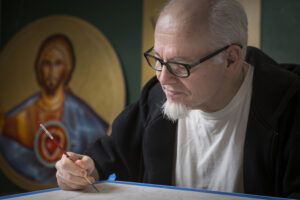 Brother Claude has been drawing and painting since childhood. He entered Mount Angel Abbey in 1972 and made his vows in 1974 at the age of 21. In 1985, Abbot Bonaventure Zerr, OSB, encouraged him to try iconography. He works primarily in acrylic, although he has used egg tempera and wax encaustic. He has written hundreds of icons. Unlike most iconographers who exactly copy outlines provided by ancient tradition, Br. Claude prefers to follow the style of classic iconography while creating original images from multiple sources of inspiration. He draws upon Roman Catholic concepts in his art, in addition to Orthodox ones.
Brother Claude has been drawing and painting since childhood. He entered Mount Angel Abbey in 1972 and made his vows in 1974 at the age of 21. In 1985, Abbot Bonaventure Zerr, OSB, encouraged him to try iconography. He works primarily in acrylic, although he has used egg tempera and wax encaustic. He has written hundreds of icons. Unlike most iconographers who exactly copy outlines provided by ancient tradition, Br. Claude prefers to follow the style of classic iconography while creating original images from multiple sources of inspiration. He draws upon Roman Catholic concepts in his art, in addition to Orthodox ones.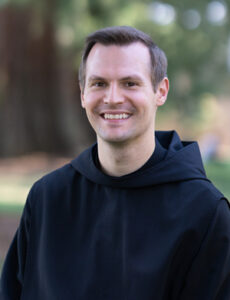 Br. Matthew Sislow, OSB, is a junior monk of Mount Angel Abbey. Raised in Walla Walla, Washington, he then went on to earn a bachelor’s degree in biology at the University of Washington in Seattle. After joining the monastery in 2019, among other assignments, he worked for about two years with Br. Claude Lane, OSB, to gather information and provide a theological read for the many icons Br. Claude has written over his decades as an iconographer. Br. Matthew studied philosophy for two years in Mount Angel Seminary, earning a master’s degree, and is now continuing graduate studies in the School of Theology.
Br. Matthew Sislow, OSB, is a junior monk of Mount Angel Abbey. Raised in Walla Walla, Washington, he then went on to earn a bachelor’s degree in biology at the University of Washington in Seattle. After joining the monastery in 2019, among other assignments, he worked for about two years with Br. Claude Lane, OSB, to gather information and provide a theological read for the many icons Br. Claude has written over his decades as an iconographer. Br. Matthew studied philosophy for two years in Mount Angel Seminary, earning a master’s degree, and is now continuing graduate studies in the School of Theology.




















